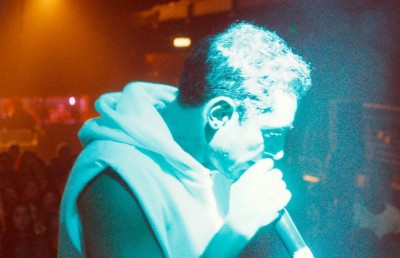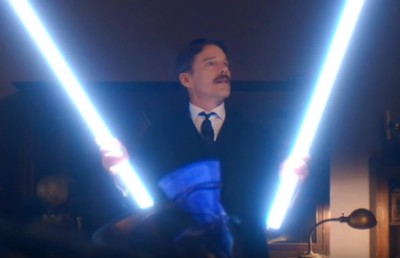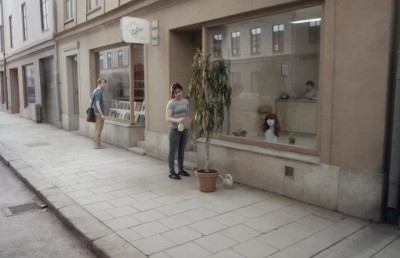About Endlessness (Roy Andersson, 2019, Sweden): A Priest, Baby Carriages and a Flying Couple
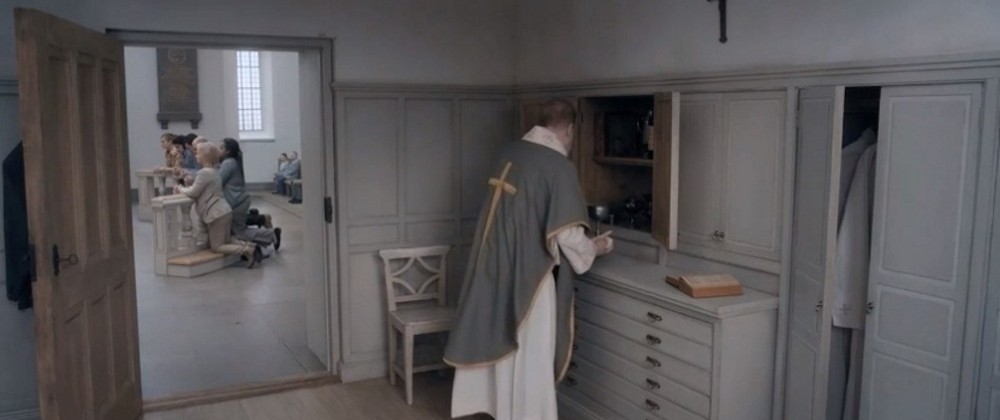
Thirty-three is the supposed age at which Jesus Christ died. Three-three is also the number of scenes in Roy Andersson’s latest film About Endlessness, about humanity’s inability to find spiritual solace in a world abandoned by God. Make no mistake, this film is a masterpiece of miserabilism, a film thankfully made by Andersson just prior to the COVID-19 lockdown, since it takes the man many years to make his finely controlled tableau’s of pain, suffering, and a little bit of human joy to remind us of what might be. The film definitely feels like a COVID-19 film, because of how the world depicted within is fractured from itself, people captured in symphonies of loneliness whether at home or in public spaces. This is a film where social distancing seems the norm. Like all of his feature films since 2000 (Songs from the Second Floor, You, the Living, A Pigeon Sat on a Branch Reflecting on Existence), About Endlessness is as rigidly controlled as a set of babushka dolls. Andersson owns his own sound studio which he uses to shoot his films, allowing him total control of every formal element, meticulously building streets, storefronts, parks, and apartments and filling in backgrounds with meticulously painted backdrops. His mise en scène owes much to the old school world of theatre set design. In this case the chosen color palette is a dusty grey, in contrast to the beige tones of A Pigeon Sat on a Branch Reflecting on Existence. Characters in his films move very deliberately and individualized characters are made up in “white face”, as if they just stepped on a 50 pound bag of white flour. The exception to this make-up regime are usually young characters, who seem less tagged to this lifeless apparel. The life-draining makeup seems more reserved for people about middle-age and older.
Stylistically Andersson is a one of a kind, an auteur in the old fashioned sense. Andersson shoots his scenes largely in static, long shot, long takes, with black frames interceding between each new scene (a gesture which recalls another miserabilist masterpiece, Stranger Than Paradise, 1984). New to this film for Andersson is the presence of a female voice-over who narrates the action of scenes either just before we see them, during them, or at the end of them. Maybe Andersson added this to remind us of his disinterest in traditional narrative suspense or urgency, like those long-winded silent cinema inter-titles which would tell us complete actions before seeing them. You are DEFINITELY in the wrong theatre for that!
Since Songs from the Second Floor, which does have a central character that runs through the film, Andersson prefers ensemble acting. In About Endlessness there are three characters who appear more than once and some continuity between scenes but most of the scenes play out as self-contained vignettes. The narrative time is mainly “sometime now”, but Andersson is not averse to injecting non-linear jumps in history, like taking us back to Nazi Germany.
When pressed to describe Andersson to someone who has never seen his work, I resort to the easy gambit of incongruous comparison that film critics often fall to: if you will, blend the seriousness of Ingrid Bergman (his Swedish compatriot), with the comic style of Jacques Tati (and his social satire), with the comic absurdity of Monty Python, and you might come out with something like Roy Andersson.
What follows is a scene by scene impression of Andersson’s flight (in some cases quite literally) of irreverent, absurdist social fantasy.
Scene 1: The Floating Couple
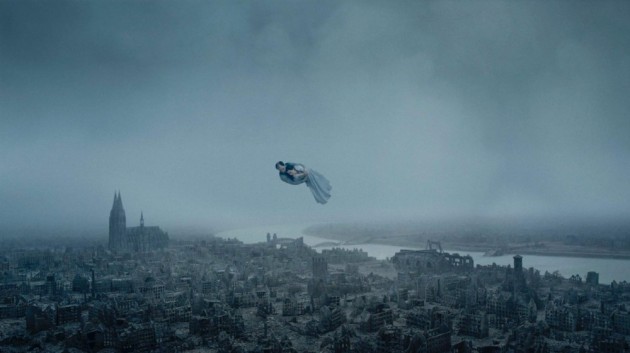
The credit sequence opens on a man and woman embraced, hovering and seemingly flying through the clouds, like a living Marc Chagall painting, like the birds we will see in the next scene, free above the ground. We hear a female choir which adds an aural layer to the celestial state. Is this couple a pair of angels? Or a married couple astral projecting themselves over a city?
Scene 2: Couple Has Descended
_630_353_90.jpg)
We are looking as a middle-aged couple seated on a park bench, their backs to the camera. They are looking up into the general area of the first scene, the sky. Is this the couple that we just saw floating in the sky? Did they imagine themselves flying like the birds? The couple remain static and silent, until they make reference to the formation of birds flying in the sky. The woman remarks: “It’s already September”. This makes sense, since Andersson is not a summer type of guy, much preferring the somber autumnal colors of the Fall and the dreary white of winter.
Scene 3: Man With a Grudge
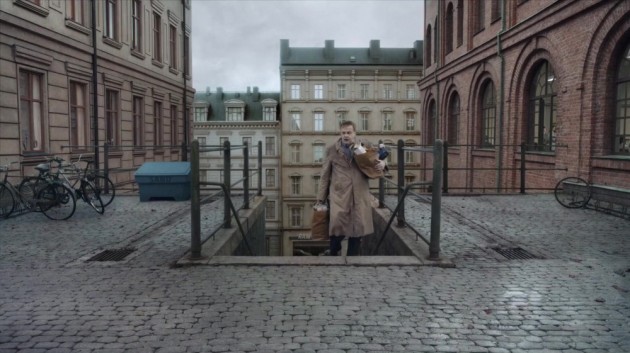
A haggard looking man walks up subway stairs carrying two packed grocery bags. Food fall out of the overstuffed bags. He is hemmed in by the tall brownstones to the side and back, the grey cobblestone ground and overcast sky and deadly still clouds visible between the buildings. As often occurs in Andersson’s films, characters treat the set as a theatrical proscenium and speak directly to the camera. This man begins to speak of a previous encounter on these steps with a high school friend and seems very concerned that the old friend did not acknowledge him. He wonders what he did to receive this social slight, then recalls that he once hurt him and this must account for the slight. In pure absurdist fashion, this man he is speaking about from his past appears behind him walking up the stairs, and slights our protagonist again. The moral here is that people hold grudges. This slight lingers and festers during the film and returns near the end.
Scene 4: The Absent-Minded Waiter
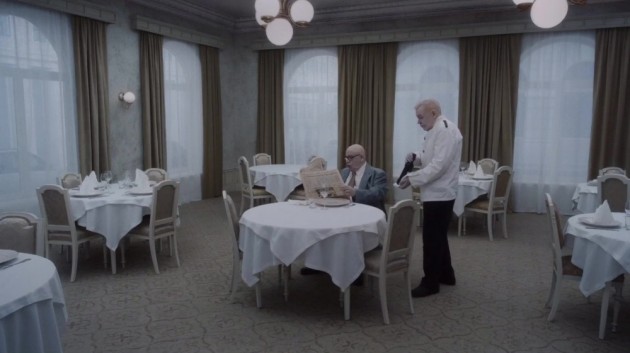
We cut to a sparse restaurant. A man is seated alone at a round table reading the newspaper while the waiter patiently awaits his approval for the bottle of wine he is holding up for him to see. A female narrator informs us of the action we are about to see, “I saw a man with his mind elsewhere….” The waiter begins to pour the wine but mindlessly keeps pouring into the overflowing glass, sending wine spilling over the white tablecloth, before he realizes his action, stops and furiously begins to dab the tablecloth while the customer stands up, startled and confused. This scene seems to be Andersson’s veiled tribute to the absent-minded waiters in Jacques Tati’s Les Vacances du M. Hulot (1953). It is slapstick a la Andersson, slowed down to a droll pace.
Scene 5: Woman Incapable of Feeling Shame
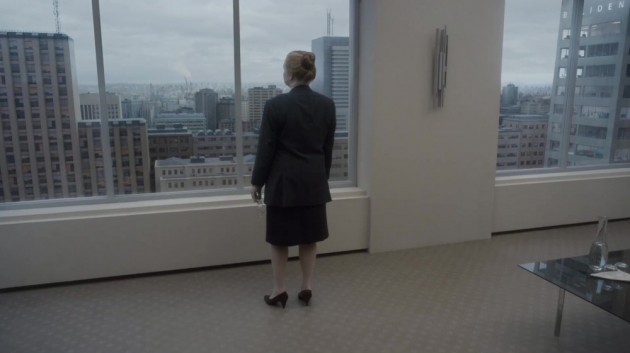
This is one of the shortest and bluntest scenes in the film. A cut takes us to a non-descript modern skyscraper office. A business lady in grey, a “communications manager” is standing looking out the endless windows overlooking the city. The female VO tells us that she in “incapable of feeling shame.” She turns to look at the camera, as if admitting some form of shame, then turns back to the window. Nothing else happens.
Scene 6: The Man and His Mattress
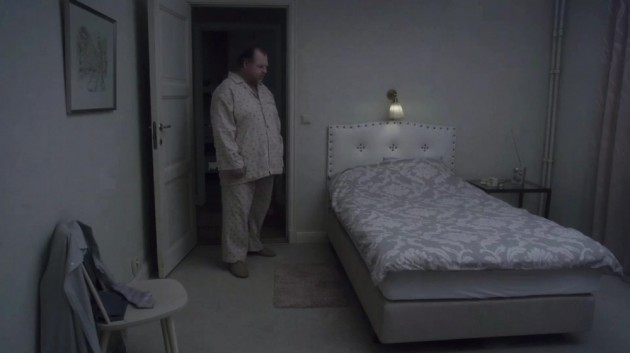
We cut to a bedroom lit and colored identically to the previous office. The open bedroom door exposes the kitchen off in the background. The kitchen lights shut and a hefty man moves from the kitchen to the bedroom. He checks under his mattress then goes to bed. The female voice-over recounts, “I saw a man who did not trust banks…..” The distrust of big business and banks is a constant theme in Andersson’s works, and it appears here in the form of civilian distrust.
Scene 7: The Priest and His Cross
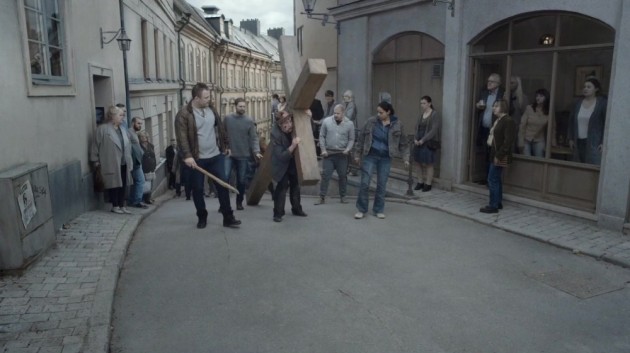
This is one of the centerpieces of the film and one of the most elaborate set-ups with up to a dozen people, a detailed city set and a fantastical action. It also introduced the character who will appear in more scenes than anyone else. The camera is at the top of a long, winding narrow city street, with people lined on either side waiting for something to appear. A man carrying a heavy wooden cross and a thorn on his head appears struggling up the road, accompanied by a crowd of followers who are not being very Christian. They yell at him, whip him, kick him, abuse him. When he falls under the cross’ weight someone helps him back up so he can suffer some more. Onlookers watch. No one helps. The camera too remains still, just observing. It is rare in an Andersson film that an onlooker will help someone in distress. In Andersson’s world each person must bear their own cross, suffer on their own. The goodness of Christ is nowhere to be found. The narrative position of this relatively long (for this film) scene is revealed in the next scene, where we see this same man who was carrying the cross wake up from a nightmare.
Scene 8: The Faithless Priest
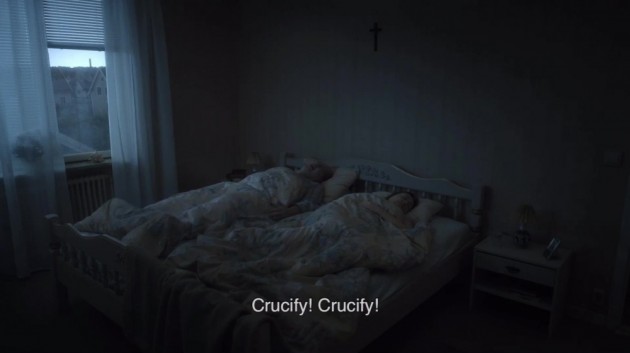
The setting changes to a darkened bedroom, a couple are asleep, and the man bearing the cross in the previous scene shivering as he wakes from a nightmare, the words “crucify, crucify”, slipping out of his mouth. He wakes up in a cold sweat, “They drove nails through my hands!” His wife comforts him with a glass of water. This character may not be the ‘hero’ or protagonist in any normal sense of the terms, but is the character Andersson comes back to several times.
Scene 9: The Shy Voyeur
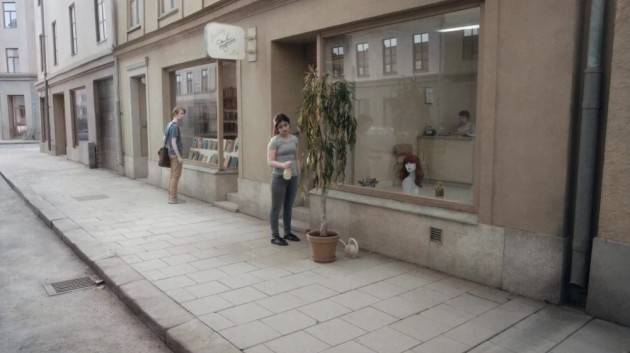
We cut back to a city street, framing a bookstore next to a hair salon. A young woman exits the salon and begins watering a potted plant in front of the store, incessantly, repeatedly. The plant cuts a sad, forlorn figure amid the concrete city jungle. A young man sporting a shoulder bag walks past her and stops to window shop in the bookstore, an excuse to look back at the woman. The simple action is given more weight by the same female voice-over: “I saw a man who has not yet found love.”
Scene 10: Priest Seeks Medical Attention
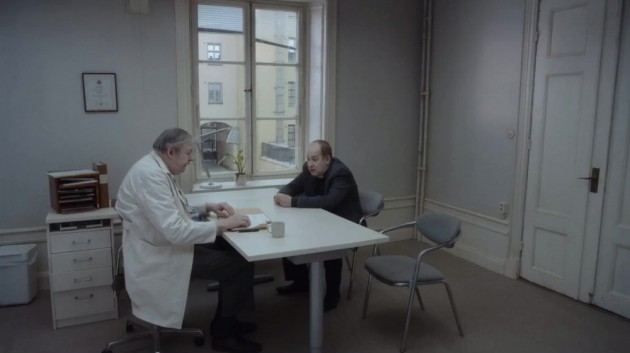
This is the third scene with the suffering priest. He is seated in his doctor’s office, seeking out help for his encroaching loss of faith. The doctor, dressed in tradition white frock, is seated across him. With this scene Andersson reduces the theme of Science vs. Religion to a comical tableau. The scene is one of the clearest reflections of my earlier noted confluence of Ingrid Bergman with Monty Python. The scene evokes at once Bergman’s famous ‘faith trilogy’ of the 1960s and the hilarious Monty Python sketch where a hapless Michael Palin pays for the privilege of a good argument but is continually frustrated by a lazy employee played by John Cleese whose idea of an argument is simply denying anything Palin says (“That isn’t an argument.” “Yes it is.” “No it is not.”, “Yes it is.” etc.). While the poor priest reveals his existential woes to his doctor (“I do not believe in God”), the doctor appears uncaring and responds with obvious platitudes (“Nightmares are nothing to be ashamed of, everyone has them.”) Or when the priest wonders why God has abandoned him,” the doctor calmly replies, “Maybe it could be that God does not exist!” The doctor appears more interested in insuring he is paid. “See you next week. I do not work for nothing. Neither do you I imagine?” The ludicrous nature of back and forth dialogue reflects Andersson’s social satire of a society disinterested in helping their fellow humans.
Scene 11: Legless Busker
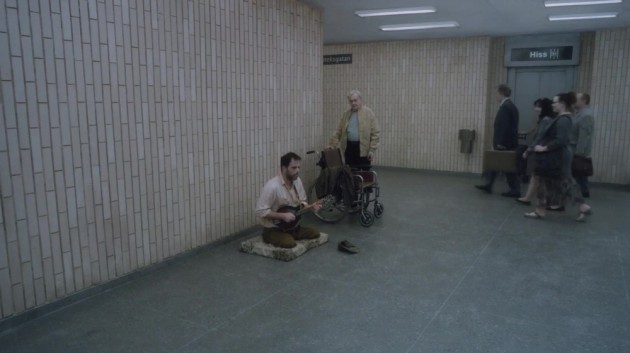
In this stand-alone scene we are in a tunnelway of an underground subway where a legless male busker plays “O’ Sole Mio” on a mandolin. A single man manning the busker’s wheelchair watches him play, as busy looking people pass by. The female voice-over for the first time gives us a backstory, “I saw a man who had stepped on a landmine and lost his legs. It made him very sad.” As in most cases, whatever the situation, in Andersson’s filmic universe people are too wrapped up in their mundanity to look beyond what is in front of them. In fact, this set, designed with a (long?) off-screen corridor to the left of the frame where people walk toward just might be a visual pun on “tunnel vision”.
Scene 12: The Trigger Happy Grandmother
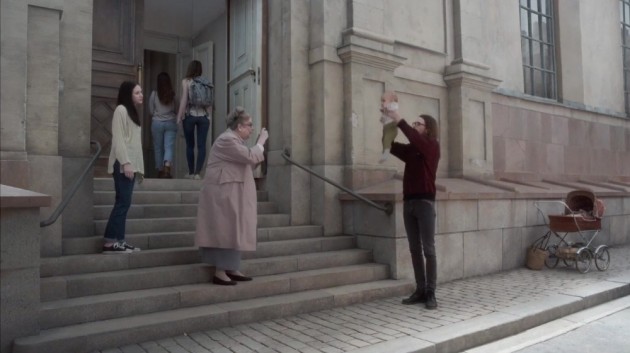
In another ludicrous stand-alone scene, the camera frames a young couple with a toddler and the grandmother standing on the steps of an officious looking concrete building. The last place one would think of for a family photo shoot! The static camera films while the grannie snaps photo after photo of the young father tossing the baby in the air. The intent of capturing an ‘action’ photo in this lifeless scenario adds to the irony. The wicker baby carriage off to the right evokes (at least for me) classic Monty Python skits (some animated by Terry Gilliam) of grannies pushing along baby carriages.
Scene 13: Priest Prepares Mass
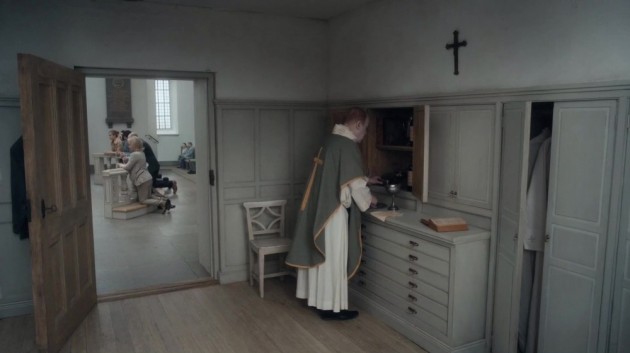
Andersson seems to love the priest character as he cuts back to him for a fourth time, this scene resting on the pure comical side as we see him off in an antechamber preparing for mass while his congregation, framed through the open door, wait patiently. After filling the chalice with wine the priest takes several long swigs from the wine bottle, then sits to settle his body before joining his ‘flock’. The half-crocked priest hobbles unsteadily through the door and begins serving the host to the seated people, struggling to keep his balance. As viewers we fear the worse, but somehow he manages to remain on his feet, a minor miracle, of sorts.
Scene 14: Grieving Parents
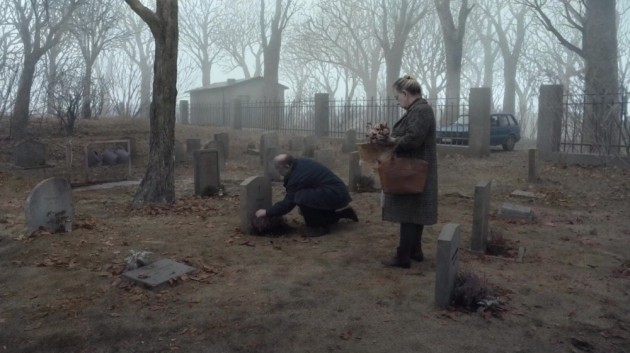
Another stand-alone scene of a middle-aged couple placing flowers on their son’s grave. The setting of the cemetery located in a foggy, overcast forest is dreary beyond belief.
Scene 15: The Flying Couple
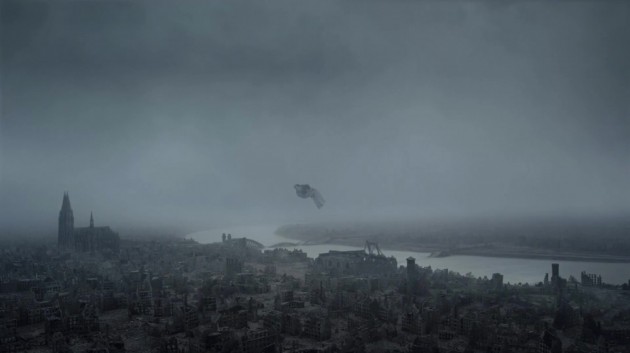
The angelic floating couple from the opening (unless there are more than one!!) returns captured in an extreme long establishing shot over the city scape of (I think) Cologne. The soundtrack is accompanied by the angelic choir. This is the only scene of the film which includes camera movement, as it pans slightly left to frame a beautiful church (maybe the location of scene 14?). Over the course of the three minute shot the couple move closer and closer to the foreground. The voice-over returns: “I saw a couple in love flying over a city known for its beauty now in ruins.” The voice-over suggests a post-apocalyptic scene. From a production standpoint the set is a painstakingly designed miniature which manifests the artistry of Andersson’s formal control.
Scene 16: The Train Station
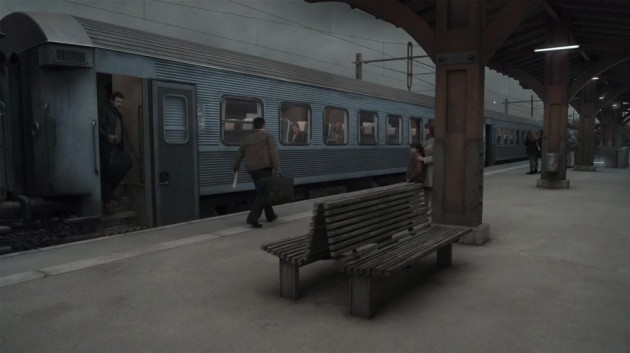
The camera cuts to a favorite Andersson location, the train station. The position of the camera angle on the platform framing the docked train recalls the framing of the Lumiere’s famous L’arrivée d’un train à La Ciotat (1895). As people begin to disembark a mother and her daughter wait for Daddy to appear. As the happy reunion ends and the family walk away, the last passenger disembarks, a young woman carrying a suitcase sadly looking around for someone to meet her. The voice-over repeats what we see: “I saw a woman who thought no one was waiting for her. The train departs, leaving her alone on the platform. She sits on a bench, waiting. A man finally arrives to meet her, bringing the sad moment to a happy end. The sound of Billie Holiday singing “All of Me” (1941) bridges the next scene, set at a bar.
Scene 17: All of Me
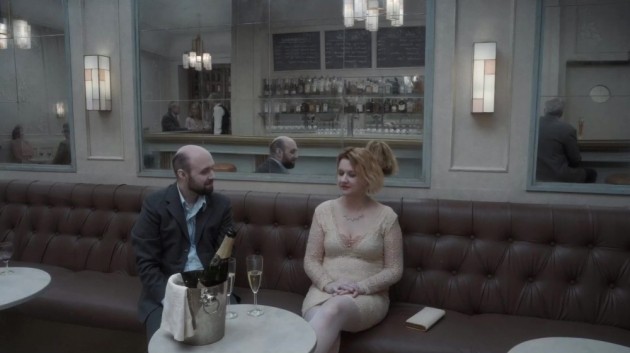
While the Billie Holiday song plays, diegetic we assume, a couple are seated in the bar, other patrons visible in a wall mirror. The woman sips champagne as the man takes pleasure in watching her. This is the most innocuous scene in the film, with very little to comment on other than to wonder what, if anything, this couple see in each other. The Billie Holiday song continues and fades into the next scene, also set in a bar/restaurant.
Scene 18: Mistaken Identity
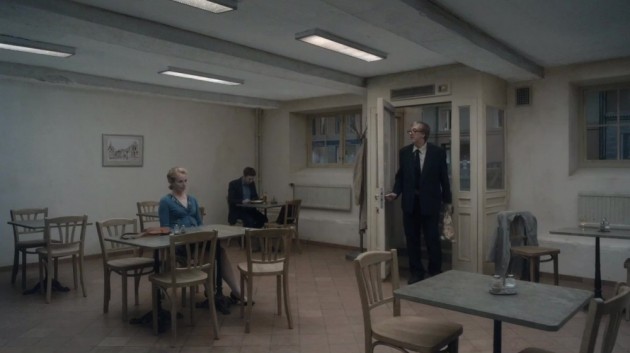
A woman is sitting alone at a table in a sparse restaurant (is it actually an eating area adjoining the previous scene?). Another man sits alone behind her eating a meal. A man enters the bar from the visible door, holding flowers. He asks the seated lady if she is Lisa Larsson, to which she replies no. The lady is joined by a burly man carrying two beers who sits at the table with the lady, while the stranger leaves the bar. The voice-over casts the stranger in a sad light: “I saw a man who had lost his way.” This line can apply to pretty much all the characters we see in this film, most notably the suffering priest.
Scene 19: The Prisoner
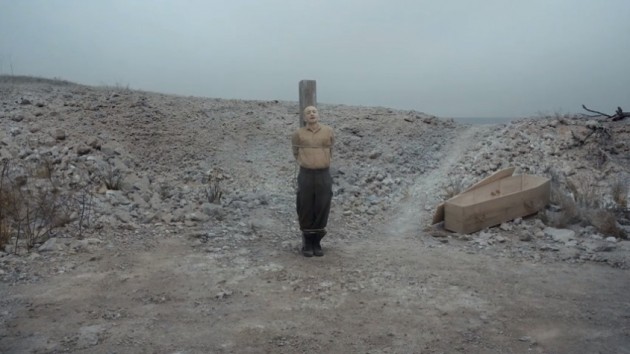
The next scene takes place outside the city, in a desolate, arid landscape. The opening image is stark, beautiful and with a tinge of Daliesque surrealism in the placement of a single wooden beam in the center and an open wood coffin to the right. A prisoner is brought into the space and tied to the wooden stake by a handful of soldiers. An army doctor joins the group. The poor man pleads for his life. The military men leave frame and the prisoner continues to plead for his life to the camera.
Scene 20: Ode to Joy
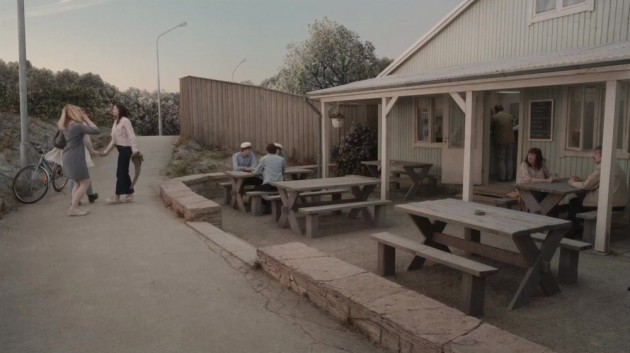
In every Andersson film there is always at least one moment of pure joy, and this is it. Three young women walking along a small country road spontaneously stop in front of a sidewalk café and begin to dance and sing along to the bouncy be-bop music coming out of the restaurant radio. People seated on the café terrace turn to watch the three women, and then show their appreciation by clapping at the end of the song.
Scene 21: The Broken Heel
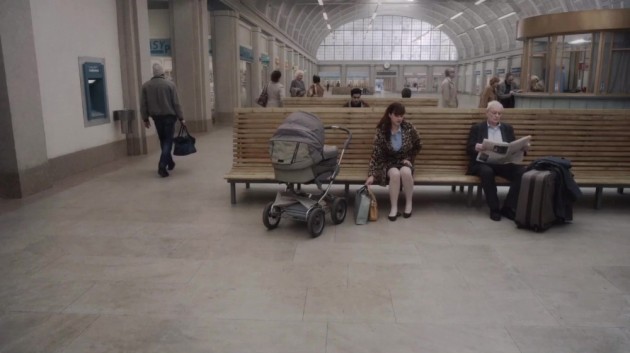
We are back at a train station. “I saw a woman who had problems with her shoe.” While a man sits on a nearby bench reading the newspaper, oblivious to his surroundings, a lady with a baby carriage discovers the heel on one of her shoes is broken. She sits next to the man, removes her shoes, places them on the carriage bottom, gets up and walks away barefoot. The newspaper man, who glanced over to take in her minor problem, goes back to his reading. The shoeless lady exits the frame. The world moves on. Maybe if this was a neorealist film, we would have the makings of a feature film: The Shoeless Woman With a Baby.”
Scene 22: A Family Tragedy
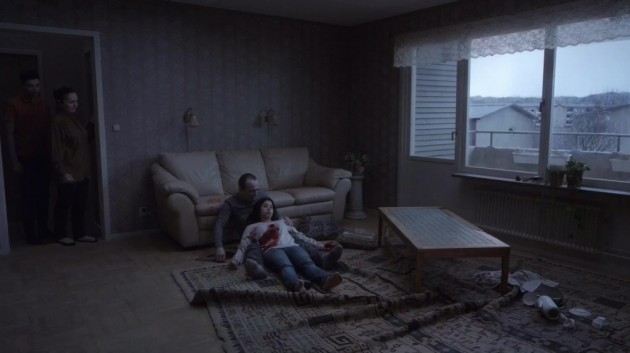
Perhaps the saddest moment in the film, a family tragedy which could have easily been avoided. We are in the living room in the aftermath of an ugly crime. A man lies on his living room floor back against a sofa, cradling the lifeless, bloodied body of his daughter. The man is crying like a baby. Two other family members look on with sad concern. As the man moves his right arm across his body we see a bloody knife clutched in his hand, the weapon used to commit the murder. The voice-over fills in the nature of the crime: “I saw a man who wanted to protect his family’s honor…and changed his mind.”
Scene 23: The Fish Market
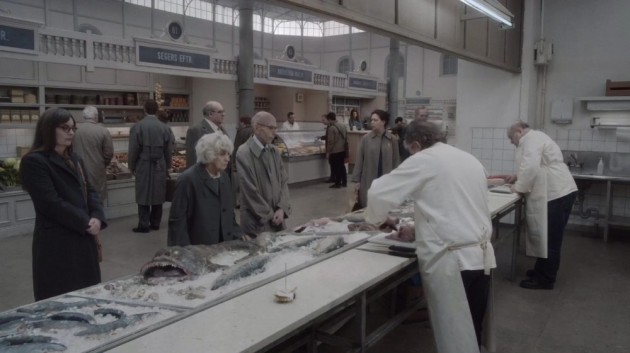
This scene takes place at a uniformly blue-grey tinged fish market, an interesting choice of location since all the actors look like dead fish with their sullen complexion. A group of people wait in front of a table showcasing various fresh fish on ice. One fish in the foreground with a huge open mouth looks particularly bizarre, maybe prehistoric! As the fishmonger prepares a fish for an elderly lady, a man and a woman behind her get into an ugly argument that gets physical. Well, it is not an argument, since it is only the man who reacts and speaks. The man slaps the woman, once, twice, three times before people from the crowd intervene and are forced to drag the man to the ground. While being held down the man professes his love for the lady he just slapped three times. She replies, “Yes, I know, I know.”
Scene 24: The Power of Science
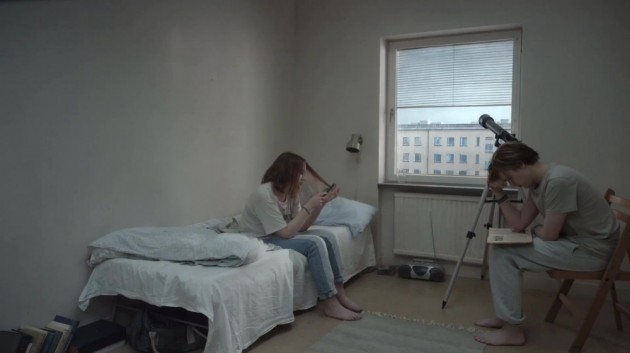
A teenage brother and sister are seated in their room, the sister lethargically combing her while the brother is immersed in a science book. A telescope points out the window. The brother reads a passage to his sister, which hints at the film’s theme: “The first law of thermodynamics states that everything is energy and it can never be destroyed. It is endless. It can only change from one form to another. That means you are energy. I am energy. And that your energy and my energy can never cease to exist. It can only transform into something new.” Somehow this idea of an energy which changes from one form to another suggests the 33 connected scenes which make up this film.
Scene 25: Hitler’s Final Days
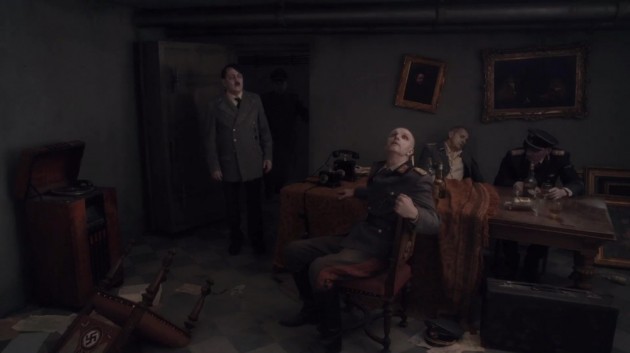
This scene breaks any sense of ‘here and the now’ by taking us back to a common time frame for Andersson: World War 2 (possibly evoked also in scene 19 by the style of military dress). We are taken back to Hitler’s bunker, and the final days of Hitler, who we see enter a room to join other Nazi officials, who muster what little strength they have left to salute their leader. The room is in a state of disrepair, chair toppled, crumbling ceiling. Off-screen sounds of air bombs fill-in the sense of the end for Hitler’s 1000 Year Reich. The five Nazis seem weak, trembling in fear of their imminent demise. It is quite enjoyable to see these men in such a state of physical and mental destitute.
Scene 26: The Crying Man
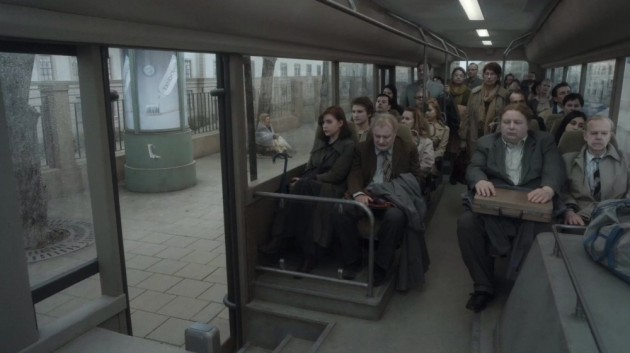
The camera cuts to the inside of a crowded bus, parked at a stop. There is a man visibly crying in the front seat. His overt and baseless (“I don’t know what I want”) tears seem to upset the people seated around him, if we go by the comments and expressions of the people seated around him. As one man bemoans, “Poor bastard. Why can’t he be sad at home.”
Scene 27: (The Not so Happy) Birthday
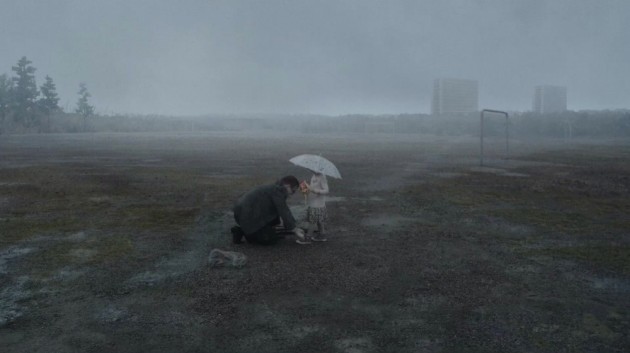
Even the idea of a children’s birthday party does not motivate Andersson to joy. In this stand-alone scene a man and his young daughter stop in the middle of a huge open field to tie their shoes. It is a miserable day, rain pouring down heavily, the sky a dreary grey. The voice-over informs us that they are on their way to a birthday party. The only thing that crosses our mind, why did the father decide to take this long path through a muddy park to get to a kid’s birthday party?
Scene 28: The Priest is Rebuffed
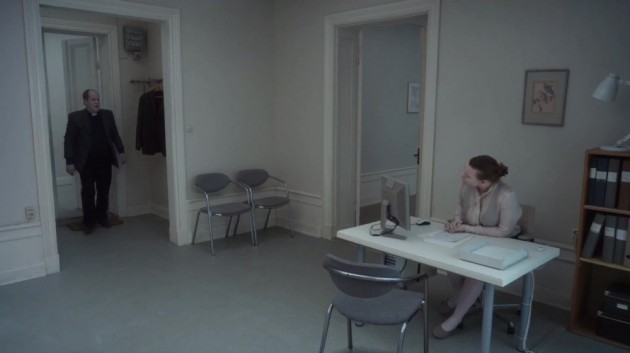
Andersson seems to love the character of the sad, faithless priest, as he returns to him for a fifth time. In this scene the priest attempts to force himself into the doctor’s office. A tone of absurdism continues in the dialogue. The priest asks the secretary, “What should I do now that I have lost my faith?” To which she replies, “I’m sorry but we are just about to close.” The doctor appears out from his office, his jacket half on, and he is no less caring, “I’m sorry but I have to catch my bus.” The poor priest persists with his existential woe, so much so that he has to be forcibly removed by the doctor and secretary from the office. We continue to hear the poor priest through the closed door. The doctor and secretary seem willing to wait him out.
Scene 29: The Dentist With No Patience
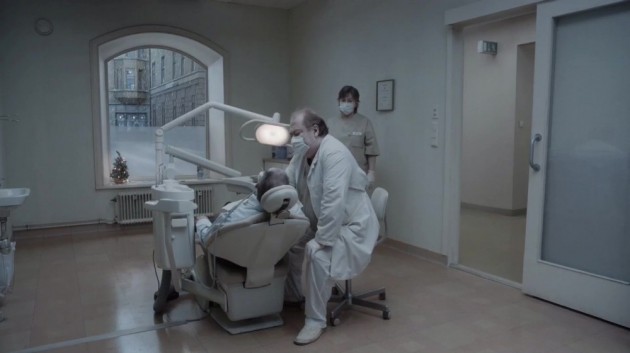
From spiritual pain to physical pain. We are in a dental office, the patient in the chair with dentist and assistant about to start the examination. Each time the dentist begins to work on his tooth the man yells in pain. He is too afraid of needles so anesthesia is out of the question. The dentist tries again but the patient yells in pain. This continues for a while until the frustrated dentist simply leaves the room. The dental assistant tries to cover for the dentist by telling the patient, “the doctor is in a bad mood, he has problems.”
Scene 30: Dentist at the Bar
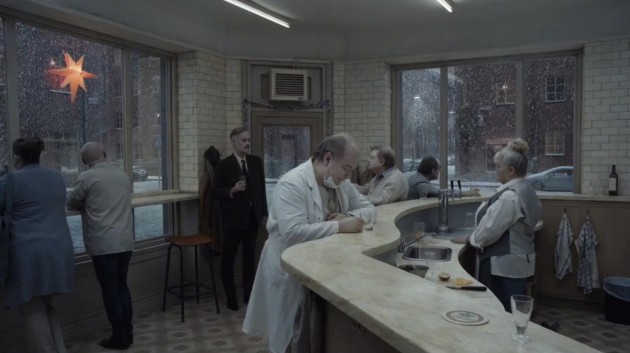
Another rare scene with a narrative link to the preceding scene. We cut to a cafe, where we see the dentist seated at the bar! Other people are looking at snow falling outside the window. A man claims, “Isn’t it fantastic?” The man standing in front of him asks, “What?” “Everything. Everything is fantastic .” “Well, yes.” The Christmas song “Silent Night” is playing in the background.
Scene 31: An Army Captured
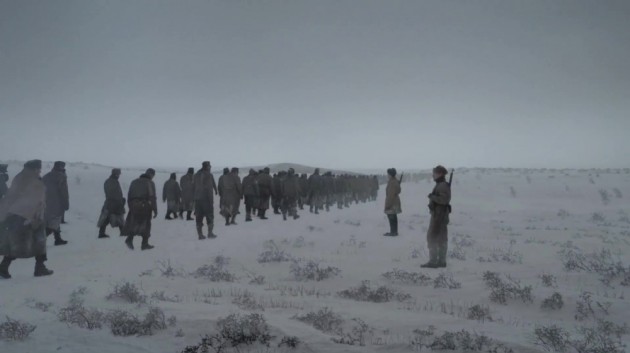
The snow falling in the previous scene continues in this location, the middle of a desolate, windy, wintry setting. Two armed soldiers are overseeing a long line of opposing soldiers being escorted away. The voice-over explains, “I saw a conquered army walking toward the prisoners camp.”
Scene 32: The Man With a Grudge
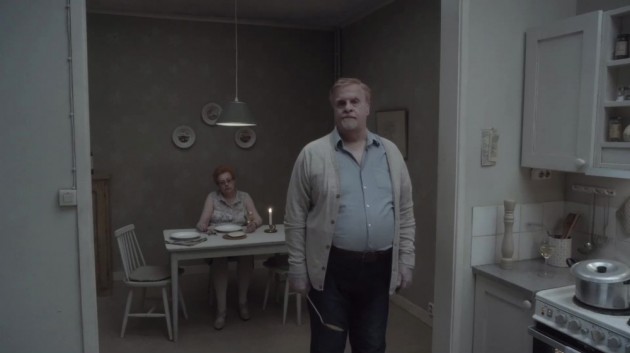
Another scene with a connective narrative tissue, as we cut back to the man from the opening who seems overly stressed about the friend who refuses to acknowledge him. He is now home in his kitchen with his wife seated behind him. This scene gives us more of the backdrop to why there may be a rift between these two former friends. The man admits his resentment over his friend’s doctoral degree, while claiming to have done nothing with his own life. His wife tries to console him, reminding him of his “achievements” in having visited Niagara Falls and the Leaning Tower of Pisa Tower and the Eiffel tower….to which the inconsolable man replies, “he probably did those things too!” “I can’t believe a loser like Sverker Olsson got a Ph.D.” No domestic bliss is to be found here.
Scene 33: The Birds Return
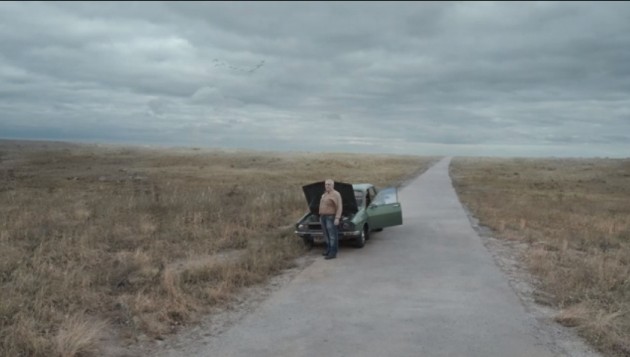
In this final scene we see a man and his broken down car stranded in the middle of nowhere. The same V-shape bird formation from the second scene appears way up in the clouds. We have come full circle. The same choir music adds a layer of celestial beauty to the proceedings.
In all but a handful of the 33 scenes that comprise About Endlessness people are either sad, angry, lonely, indifferent, distraught or in some kind of pain. In About Endlessness people are marooned physically or psychologically everywhere, in subways, train platforms, floating in the clouds, bus stops, churches, homes, strangely giving the film a COVID-19 pandemic feel. Andersson is a peculiar stylist, standing alone from the crowd, not giving in to modern trends in technology, style, or media preferences. In a period where popular taste veers toward fast, easy to digest stories and images, Andersson continues along his contemplative, ‘moment to moment’ style of social commentary. It is strange that I am largely an optimist, yet I love the films of Roy Andersson.



